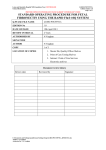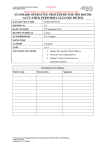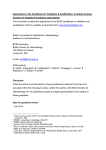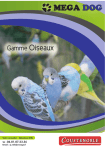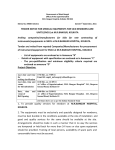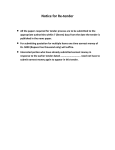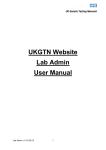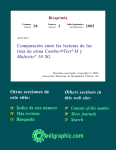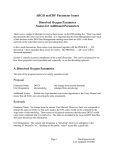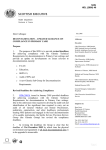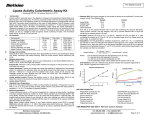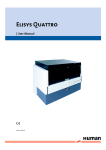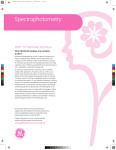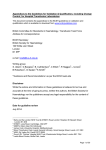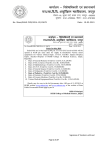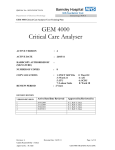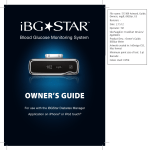Download Document title: fill in the title of your SOP
Transcript
Luton and Dunstable Hospital NHS Foundation Trust CONTROLLED
Clinical Biochemistry Department
LI-BIO-Bil3SOPUr
Edition No 2.0
Page 1 of 16
PRINTED COPIES UNCONTROLLED UNLESS MARKED “CONTROLLED” IN RED
STANDARD OPERATING PROCEDURE FOR PFAFF BILIMETER III
BILIRUBINOMETER AND ASSOCIATED CENTRIFUGE
Q-PULSE FILE NAME
LI-BIO-Bil3SOPUr
EDITION No
2.0
DATE OF ISSUE
18th September 2012
REVIEW INTERVAL
2 Years
AUTHORISED BY
N A Smith
SIGNATURE
AUTHOR
N A Smith
COPY
2 of 3
1. Master file, Quality Officer Shelves
LOCATION OF COPIES
2. Point of Care Testing Shelves
3. Intranet / Point of Care Services
Electronic archives
Document review history
Review date
June 2009
Reviewed by
N Smith
June 2010
N Smith
July 2011
N Smith
July 2012
N Smith
Signature
C:\Documents and Settings\nasmith\Local Settings\Temp\LI-BIO-Bil3SOPUr_2AE4E04F.doc
Author N A Smith
Authorised by N A Smith
Luton and Dunstable Hospital NHS Foundation Trust CONTROLLED
Clinical Biochemistry Department
LI-BIO-Bil3SOPUr
Edition No 2.0
Page 2 of 16
PRINTED COPIES UNCONTROLLED UNLESS MARKED “CONTROLLED” IN RED
DOCUMENT AMENDMENT FORM FOR STANDARD OPERATING PROCEDURE
FOR UNISTAT BILIRUBINOMETER AND ASSOCIATED CENTRIFUGE
Record Filename LI-BIO-Bil3SOPUr
Number Date
Page
Amendment
Authorised by
Number
July 12
All
Updated in line with new LI-BION A Smith
1
SOP4POCT template; changes
throughout
July 12
5-6
Updated responsibilities
N A Smith
2
3
July 12
7
4
July 12
13
5
July 12
14
6
July 12
15
Training and Competency Section 1.1
expanded
Included contact details for service
engineer
Included Sections 3.7, 3.8 & 3.9 Audit,
Comparability and Uncertainty
Included self assessment competency
form
N A Smith
N A Smith
N A Smith
N A Smith
7
8
9
10
The amendment must be authorised by the POCT Manager to ensure all copies
including the electronic version are updated simultaneously.
Any minor amendment must be handwritten without obscuring the previous text. An
asterisk is written in the adjacent margin to highlight the alteration and is signed and
dated by the POCT Manager.
Amendments requiring immediate action must be handwritten without obscuring the
previous text. An asterisk is written in the adjacent margin to highlight the alteration
and is signed and dated by the POCT Manager.
Ten or less minor amendments may be recorded before a new edition is issued.
Major changes must result in the immediate review of the procedure.
Document amendment does not replace the review process.
C:\Documents and Settings\nasmith\Local Settings\Temp\LI-BIO-Bil3SOPUr_2AE4E04F.doc
Author N A Smith
Authorised by N A Smith
Luton and Dunstable Hospital NHS Foundation Trust CONTROLLED
Clinical Biochemistry Department
LI-BIO-Bil3SOPUr
Edition No 2.0
Page 3 of 16
PRINTED COPIES UNCONTROLLED UNLESS MARKED “CONTROLLED” IN RED
HAZARDS AND PRECAUTIONS
For appropriate use of protective clothing, please refer to ‘Use of Personal Protective
Equipment (PPE) in Pathology and Phlebotomy’.
Substance
Hazards
IQC/EQA
Specimens
Danger of infection
Blood
Danger of infection
Used glass
capillary tube
Danger of infection
Blood stained
gauze etc
Danger of infection
PDI Sanicloth 70
Irritating to eyes (R36)
Highly flammable (R11)
Precaution
Follow standard precautions
(see above). Dispose of in
orange clinical waste bags.
Follow standard precautions
(see above). Dispose of in
orange clinical waste bags.
Follow standard precautions
(see above). Dispose of in
sharps bin
Follow standard precautions
(see above). Dispose of in
orange clinical waste bags.
Keep away from sources of
ignition. No smoking.
First aid
Code*
A1, B, C
A1, B, C
A1, B, C
A1, B, C
A, B, C
IF IN ANY DOUBT CONSULT A SENIOR MEMBER OF STAFF OR
YOUR SAFETY REPRESENTATIVE
Key:
*A1 Ingestion: wash mouth thoroughly with water and give plenty to drink. In severe
cases obtain medical attention.
B
Eye contact: irrigate thoroughly with water. Seek medical help.
C
Skin contact: wash off skin thoroughly with water.
D
Inhalation: remove to fresh air. If severe call a physician.
If First Aid treatment has to be given, contact the nearest first aider but do not delay
treatment to the casualty.
If necessary, call the crash team 2222.
Treat all body tissue and waste as potentially infective.
In all cases, fill in an Incident form and report to Occupational Health or Accident
Service if out of hours.
See Also Risk Assessments on Intranet - Departments/Pathology/POCT
Using a Bilirubinometer 98
Blood or Body Fluid Analysis 101
C:\Documents and Settings\nasmith\Local Settings\Temp\LI-BIO-Bil3SOPUr_2AE4E04F.doc
Author N A Smith
Authorised by N A Smith
Luton and Dunstable Hospital NHS Foundation Trust CONTROLLED
Clinical Biochemistry Department
LI-BIO-Bil3SOPUr
Edition No 2.0
Page 4 of 16
PRINTED COPIES UNCONTROLLED UNLESS MARKED “CONTROLLED” IN RED
TABLE OF CONTENTS
0 INTRODUCTION................................................................................................................... 5
0.1 Purpose and Scope ........................................................................................................... 5
0.2 Clinical Indication ............................................................................................................ 5
0.3 Responsibilities ................................................................................................................ 5
0.4 References ........................................................................................................................ 6
0.5 Definitions........................................................................................................................ 7
0.6 Related Documents .......................................................................................................... 7
1 PRE-EXAMINATION PROCESS ......................................................................................... 7
1.1 Training and Competency ................................................................................................ 7
1.2 Patient Preparation ........................................................................................................... 7
1.3 Primary Blood Specimens ................................................................................................ 7
1.4 Spillage of Clinical and Non-Clinical Waste ................................................................... 8
1.5 Retention of Clinical Material and Records ..................................................................... 8
1.6 Disposal of Clinical and Non-Clinical Waste .................................................................. 8
2 EXAMINATION PROCESS .................................................................................................. 8
2.1 Analytical Principle.......................................................................................................... 8
2.2 Limitations of Analytical Procedure ................................................................................ 8
2.2.1 The Device ................................................................................................................ 8
2.2.2 Cross-reactivity ......................................................................................................... 8
2.2.3 Interferences .............................................................................................................. 8
2.2.4 Specimens Unsuitable for Analysis........................................................................... 8
2.2.5 Safety Notices ........................................................................................................... 9
2.3 Central Database and Connectivity .................................................................................. 9
2.4 Equipment ........................................................................................................................ 9
2.5 Reagents/Consumables..................................................................................................... 9
2.6 Calibration........................................................................................................................ 9
2.7 Quality Assurance Programme......................................................................................... 9
2.7.1 Internal Quality Control ............................................................................................ 9
2.7.2 External Quality Assessment .................................................................................. 10
2.8 The Test Procedure......................................................................................................... 10
2.9 Results ............................................................................................................................ 11
2.10 Maintenance ................................................................................................................. 11
2.10.1 As required ............................................................................................................ 12
2.10.2 Weekly .................................................................................................................. 12
2.11 Troubleshooting ........................................................................................................... 12
3 POST-EXAMINATION PROCESS ..................................................................................... 13
3.1 Reference Values............................................................................................................ 13
3.2 Reporting the Results ..................................................................................................... 13
3.3 Interpretative Comments ................................................................................................ 13
3.4 Reviewing Previous Results........................................................................................... 14
3.5 Performance Criteria ...................................................................................................... 14
3.6 Documentation ............................................................................................................... 14
3.7 Audit of Results and Indication...................................................................................... 14
3.8 Comparability................................................................................................................. 14
3.9 Uncertainty of Results.................................................................................................... 14
APPENDIX 1 SELF ASSESSMENT COMPETENCY FORM.............................................. 15
C:\Documents and Settings\nasmith\Local Settings\Temp\LI-BIO-Bil3SOPUr_2AE4E04F.doc
Author N A Smith
Authorised by N A Smith
Luton and Dunstable Hospital NHS Foundation Trust CONTROLLED
Clinical Biochemistry Department
LI-BIO-Bil3SOPUr
Edition No 2.0
Page 5 of 16
PRINTED COPIES UNCONTROLLED UNLESS MARKED “CONTROLLED” IN RED
0 INTRODUCTION
0.1 Purpose and Scope
The Pfaff Bilimeter III bilirubinometer is used for the determination of bilirubin levels in
serum for the investigation of neonatal jaundice. This document describes the procedure to be
followed to ensure the provision of reproducible and accurate patient results for the Clinician
to act upon.
The bilirubinometers are located on Wards 33 and 32 and are used to process specimens from
the respective wards. There is also a Hettich Micro haematocrit Centrifuge for separation of
plasma from cells.
Bilirubin may also be analysed on some blood gas analysers within the Trust and on the
laboratory analysers.
0.2 Clinical Indication
Neonatal jaundice associated with an elevated serum bilirubin level is a common
physiological condition occurring shortly after birth due to immaturity of hepatic systems and
usually resolves without treatment. However, a high concentration of bilirubin can cause
brain damage (kernicterus) and requires investigation of the underlying cause. A dangerously
high level of bilirubin is treated by phototherapy or exchange transfusion. Regular
monitoring of serum bilirubin is essential in neonates with jaundice and this is most
effectively done using Point of Care Test (POCT) methodology.
When following trends in bilirubin results, users must be made aware that results may differ
between POCT analysers or POCT analysers and the laboratory method. Analytical variation
is discussed in the user training sessions. The laboratory recommends review of results from
one method used in series wherever possible, this reveals trends in results most clearly.
0.3 Responsibilities
POCT Management Group ensures:
The responsibilities, authority and interrelationships of all personnel involved in
POCT are specified and communicated with the organisation;
Staff performing PCOT receive appropriate training, supervision and competence
testing;
The selection of POCT devices and systems includes their practicability and the
comparability of their results with those obtained in the laboratory;
The reports of the POCT quality assurance programme(s) are reviewed by the group
and advice on improvement is provided and implemented.
Senior Pathology Management Staff ensure:
Departmental policies and procedures are in accordance with the requirements of the
MHRA bulletins, Trust Medical Devices Management Policy, and all relevant quality
standards to which the organisation subscribes;
The needs and requirements of the users are reviewed regularly;
Persistent problems are escalated to the relevant manufacturer and actioned;
Determining and documenting back up plans if equipment is out of action;
Responds to serious service loss in liaison with Bleep 555 holder.
Clinical Biochemistry Staff with POCT responsibilities ensure:
Regular tasks in the management of the POCT service are carried out;
Persistent problems are notified to senior departmental staff.
Clinical Biochemistry staff out of hours:
Should not leave the laboratory to trouble-shoot POCT as this compromises the oncall service
Should instigate back up procedures, where appropriate, and cascade serious service
loss as appropriate to the on-call Consultant.
C:\Documents and Settings\nasmith\Local Settings\Temp\LI-BIO-Bil3SOPUr_2AE4E04F.doc
Author N A Smith
Authorised by N A Smith
Luton and Dunstable Hospital NHS Foundation Trust CONTROLLED
Clinical Biochemistry Department
LI-BIO-Bil3SOPUr
Edition No 2.0
Page 6 of 16
PRINTED COPIES UNCONTROLLED UNLESS MARKED “CONTROLLED” IN RED
Users ensure:
Their annual training is kept up to date and they are competent to practice;
The correct specimen is obtained from the correct patient under the correct
circumstances and the correct specimen is tested;
Ensure the specimen is collected with minimal discomfort to the patient;
The test is carried out according to the manufacturer’s instructions;
The specimen is disposed of according to the Trust Waste Management Policy;
Clinical biochemistry POCT staff are informed in the event of problems with the
device;
If issued with a log-on or barcode this is kept secure and used only be themselves.
Sharing or photocopying barcodes or log-on details is a disciplinary offence
according to Trust Information Technology Security Policy;
The results are reported as appropriate.
Ward / Department managers ensure:
Users of the equipment keep their training up to date and maintain their competency;
Adequate supplies of consumables are maintained;
Appropriate resources are available;
Proper records of training and competency are maintained;
That faulty equipment is taken out of use;
Notifies the POCT team if equipment becomes obsolete or no longer required.
Infection control team / Nurse Safety representative ensures:
Performs risk assessment for handling biological material;
Advises on precautions to be undertaken when handling the biological material
including spillages, and safe disposal;
Advises on safety of products before purchase;
Updates COSHH details and advises on precautions to be taken when handling all
material including spillage, breakage and disposal.
Manufacturers ensure:
The user is kept up to date with information regarding the device and the associated
products that they provide;
Provide training sessions for the user in order to provide competent use of the
instrument;
Provide regular audits of the equipment;
Fulfil the criteria agreed in the maintenance and service contract.
0.4 References
Management of In Vitro Diagnostic Medical Devices, MDA Bulletin DB2002 (02)
PD-GEN-MDAIVDMg
Management and Use of IVD Point of Care Test Devices, MDA Bulletin DB2010 (02)
PD-GEN-MDAPOCTMg
Trust Point of Care Testing Policy MP-GEN-LDHPOCTPo
Trust Infection Control Policy MI-GEN-LDHInfCrl
Point of Care Testing Policy in Blood Sciences LP-BLS-POCTPol
ACB National Audit Group and UKNEQAS Clinical Chemistry Specialist Advisory
Group for Paediatric Investigations ‘Investigation of neonatal jaundice: standards for
the measurement of total and conjugated bilirubin and interpretation’ MP-BIOACBPdBlGd
C:\Documents and Settings\nasmith\Local Settings\Temp\LI-BIO-Bil3SOPUr_2AE4E04F.doc
Author N A Smith
Authorised by N A Smith
Luton and Dunstable Hospital NHS Foundation Trust CONTROLLED
Clinical Biochemistry Department
LI-BIO-Bil3SOPUr
Edition No 2.0
Page 7 of 16
PRINTED COPIES UNCONTROLLED UNLESS MARKED “CONTROLLED” IN RED
0.5 Definitions
User – Any person who handles the device whether it is used directly to produce results or
indirectly for maintenance and Quality Assurance procedures. This includes Clinicians,
Nursing Staff, Healthcare Scientists and Medical Device Technicians as necessary.
EQAS – External Quality Assurance Scheme
POCT – Point of Care Testing
SOP – Standard Operating Procedure
IQC – Internal Quality Control
MHRA – Medicines and Healthcare Products Regulatory Agency
TPN – Total Parenteral Nutrition
0.6 Related Documents
Trust Health and Safety Policy MP-GEN-LDHH&SPol
Trust Waste Management Policy MP-GEN-LDHWsMgP
Trust Information Technology Security Policy MP-GEN-LDHIM&TPO
Bilimeter 3 + Prufsonde User Manual LI-BIO-NPTBil3Ur
Hettich Haematocrit 210 Centrifuge Manual LI-BIO-NPTHctHet
Trust Guidelines for the management of neonatal jaundice (CG91)
Neonatal Jaundice (NICE guideline)
Patient Results and Quality Control Book
Laboratory Bilirubin record book
POCT Annual Self-Assessment Competency Statement for Pfaff III Bilirubinometer
(See Appendix 1)
1 PRE-EXAMINATION PROCESS
1.1 Training and Competency
Bilirubin analysis should only be carried out by trained and competent users. Training
sessions can be arranged by contacting the POCT team on Ext 7991. Staff working on Wards
32 or 33 can be trained. Training records and self-assessment competency documents are
kept by the POCT team. The self-assessment competency forms are available as an Appendix
to this document.
1.2 Patient Preparation
The area of skin to be lanced should be warm and relaxed. It should be cleaned with water
and dried to avoid interference from contaminants on the skin or dilution from water used for
washing.
Care should be taken if babies are on TPN containing lipids, as highly lipaemic specimens
(serum appears cloudy) are not suitable for analysis. The specimen should ideally be taken 4
hours after the TPN has been stopped in this case. Measurement of bilirubin by
bilirubinometers (direct spectrophotometry) is only possible in neonates
1.3 Primary Blood Specimens
Blood from heel pricks using a Unistik must be collected into a bilimeter capillary. These are
glass and have a small green band at one end. Only the glass capillaries supplied by Sartorius
are suitable for use with this analyser, any other capillary will give unreliable results. A very
small amount of serum is required for bilirubin analysis and the capillary should only be ½ to
2/3 filled with blood.
Bilirubin is photosensitive both to artificial light and direct sunlight and specimens should
therefore be analysed immediately. .
Alternatively blood can be taken from indwelling venous or arterial lines.
C:\Documents and Settings\nasmith\Local Settings\Temp\LI-BIO-Bil3SOPUr_2AE4E04F.doc
Author N A Smith
Authorised by N A Smith
Luton and Dunstable Hospital NHS Foundation Trust CONTROLLED
Clinical Biochemistry Department
LI-BIO-Bil3SOPUr
Edition No 2.0
Page 8 of 16
PRINTED COPIES UNCONTROLLED UNLESS MARKED “CONTROLLED” IN RED
1.4 Spillage of Clinical and Non-Clinical Waste
Spillage of clinical and non-clinical waste must be dealt according to the Trust Health and
Safety Policy.
1.5 Retention of Clinical Material and Records
There is no clinical material to keep.
Bilirubinometer glass capillaries should be disposed of into a sharps bin after use.
Used Cristaseal putty strips should be disposed of as clinical waste once completely used.
Patient results must be transcribed into the patient’s notes.
Patient results must also be immediately transcribed into the Patient Results and Quality
Control Book and the patient’s notes. The Patient Results and Quality Control Book must be
kept beside the analyser. When full these books must be kept in a secure place on the ward
for the lifetime of the instrument (or if required by other guidelines, for the longest time
period deemed necessary).
Training and self assessment of competency records are kept by the POCT team.
1.6 Disposal of Clinical and Non-Clinical Waste
Clinical and non-clinical waste must be disposed of according to the Trust Health and Safety
Policy.
2 EXAMINATION PROCESS
2.1 Analytical Principle
The Pfaff Bilimeter III bilirubinometer is a dual wavelength direct spectrophotometer. Light
beams with wavelengths of 455nm (nanometers) and 575nm (nanometers) pass successively
through the serum in the haematocrit capillary tube placed in the specimen holder. Bilirubin
has a maximum absorption wavelength between 450 and 460nm (nanometers) and
haemoglobin at 575nm (nanometers). The possible effects of haemoglobin present in sera
derived from haemolysed specimens are compensated for by deducting the absorbance at
575nm (nanometers) from that at 455nm (nanometers).
2.2 Limitations of Analytical Procedure
2.2.1 The Device
The specimen size required is ~4L (microlitres).
The manufacturer’s quoted linear range is 0-488mol/L (microlitres) (±3%)
The analyser is operational between 15-30oC at under 70% humidity (with no
condensation). The analyser should be kept out of direct sunlight and dust should be
avoided.
Opaque plasma is not suitable for analysis due to the presence of lipaemia. Severely
haemolysed plasma (red in colour) is also not suitable for analysis.
2.2.2 Cross-reactivity
Any substance, which absorbs appreciably at 460nm (nanometers), is a potential
interferent. These include lipochromes and carotenoids and these will affect results.
In neonates such substances are usually absent, but are present with increasing age.
2.2.3 Interferences
Drugs such as amines, fatty acids, phenols and sulfonamides may interfere with
bilirubinometer measurements. Intravenous fat emulsions have also interfered with
direct spectrophotometric measurements.
2.2.4 Specimens Unsuitable for Analysis
The serum of newborn infants does not contain the potential interferents such as
carotenoids and other pigments, which may be found in older children and adults. The
bilirubinometer is thus only suitable for use in neonates (up to one month of age, or
one month from term if premature).
C:\Documents and Settings\nasmith\Local Settings\Temp\LI-BIO-Bil3SOPUr_2AE4E04F.doc
Author N A Smith
Authorised by N A Smith
Luton and Dunstable Hospital NHS Foundation Trust CONTROLLED
Clinical Biochemistry Department
LI-BIO-Bil3SOPUr
Edition No 2.0
Page 9 of 16
PRINTED COPIES UNCONTROLLED UNLESS MARKED “CONTROLLED” IN RED
2.2.5 Safety Notices
There are no known safety notices
2.3 Central Database and Connectivity
There is currently no connectivity or central database for the Bilimeters.
2.4 Equipment
Pfaff Bilimeter III analysers and Hettich Haematocrit 210 centrifuges are located in the
Clinical Room on Ward 32 (Serial number B39052133) and Ward 33 (Serial number
B38051939).
The analyser and centrifuge require a power supply and adequate bench space. Access to
hand washing facilities and suitable disposal facilities for biological waste are also required.
The analyser must be installed on a hard level surface in a well-ventilated area.
The power switch is located on the front of the instrument. Before turning on the analyser pull
out the cell holder and confirm that there is no capillary in the cell holder, that there is no dust
etc around the inlet for the capillary tube or around the slit. Turn on the power switch with
the cell holder inserted (but no capillary). The LCD will display ‘Total Bilirubin’. A
countdown will start from 30 to 0. When the display shows 0.0µmol/L (micromol/L) the
device is ready for use. Quality control checks must be carried out before patient testing.
Switch on the centrifuge at the rear of the machine and after a few seconds the ‘Open Lid’
symbol will light up. The lid can now be opened.
The analysers and centrifuge are covered by a maintenance contract.
2.5 Reagents/Consumables
Bilimeter capillaries, (Part number 105000) and Cristaseal putty (Part Number 106000) are
ordered by the ward manager from Sartorius Ltd (01372 737100). The putty must be kept in a
sealed bag to prevent it drying out.
Unistix Lancets Neonatal (Owen Mumford) are ordered on a stock requisition order form
from supplies. 1 box contains 100 lancets (Part No. AT072)
Control cuvette and light proof box. The control cuvette must be kept in the light proof box at
all times apart from the short time when it is tested on the analyser.
PDI Sanicloth 70 (stock requisition).
All the above supplies are kept in the clinical room on Wards 32 and 33 respectively at room
temperature. Stock records must be kept by the wards.
Internal Quality Control Liquicheck Paediatric Control Level 2 from Bio-Rad. It is only
stable for 1 week and is stored in Clinical Biochemistry Fridge 003. It is the same as that
used in the laboratory and is tested by Biochemistry staff weekly.
2.6 Calibration
The analyser is calibrated at manufacture and this is checked yearly as part of the engineer’s
maintenance visit. The users can not perform calibration processes.
2.7 Quality Assurance Programme
2.7.1 Internal Quality Control
Ward Staff:
Ward staff must carry out quality control using the control cuvette before every patient
test. The control cuvette should additionally be processed if the analyser has been
moved or switched off.
The control cuvette is contained in its own separate light proof box and must be kept
in this closed box when not in use.
1. Insert the control cuvette and holder into the meter, matching the red dot on the
holder with the red dot on the meter.
2. The result will be displayed almost immediately. Do not press any buttons!
3. The result must be within the range:
Ward 32: 264-304µmol/L (micromole/L), target 284 µmol/L
C:\Documents and Settings\nasmith\Local Settings\Temp\LI-BIO-Bil3SOPUr_2AE4E04F.doc
Author N A Smith
Authorised by N A Smith
Luton and Dunstable Hospital NHS Foundation Trust CONTROLLED
Clinical Biochemistry Department
LI-BIO-Bil3SOPUr
Edition No 2.0
Page 10 of 16
PRINTED COPIES UNCONTROLLED UNLESS MARKED “CONTROLLED” IN RED
Ward 33: 173-199µmol/L (micromole/L), target 186 µmol/L
4. If the result is in range, proceed with patient testing. If the result is outside the
range DO NOT USE the instrument. Follow the instructions in section 2.7 and
2.8.
5. Record all control values in the patient’s results and quality control book.
6. Return the control cuvette to the light proof box and close the lid.
Laboratory POCT staff:
Internal Quality Control will be processed weekly by Clinical Biochemistry staff and
when troubleshooting. The quality control material is Liquicheck Paediatric Control
Level 2 from Bio-Rad. It is only stable for 1 week. Results are recorded in the
Patient’s Results and Quality Control Book and in the laboratory Bilirubin book. Out
of range IQC results will be investigated.
2.7.2 External Quality Assessment
UKNEQAS Paediatric Bilirubin scheme, monthly, 3 specimens will be processed by
Clinical Biochemistry staff. The results are recorded in the Patients Results and
Quality Control Book. Poor performance will be investigated by Clinical
Biochemistry Staff and is defined as an A score over 200.
POCT staff record EQA failure on ‘Laboratory Non Conformity Form’ for later
review. (A CAPA template has been set up in Q Pulse for use for management of non
conformities).
The Ward Managers will receive a simplified report indicating how their analyser is
performing. This should be kept with the equipment records for the analyser.
2.8 The Test Procedure
Each user of the Bilirubinometer and the centrifuges must be trained and be self-assessed as
competent (See Appendix 1 – Self assessment competency form).
If the analyser is out of commission, report the problem to Clinical Biochemistry Staff (Tel
7991 Monday to Friday, 9am to 5pm). If the analyser is not available, back up may be
arranged between the midwife in charge on wards 32 and 33. If both analysers are out of
action, an orange paediatric specimen tube should be sent to the laboratory for bilirubin
analysis by the laboratory method.
Gloves must be worn when handling blood specimens, using the bilirubin analyser or
centrifuge. Specimens should be centrifuged and analysed immediately because bilirubin is
photosensitive both to artificial light and direct sunlight.
Test Procedure:
1. Collect blood into the glass capillary tube, holding the end with the green line. Collect
blood to fill only ½ to ⅔ of the capillary. When the required volume of blood has
been collected, seal the capillary tip with the Cristaseal putty. Hold the end of the
capillary with the green line and insert the capillary into the putty at right angles to the
face of the putty. Push in and then twist and pull out the capillary. This should ensure
a secure seal. Do not use the Cristaseal if it is dry and hard.
2. To open the lid, turn the blue handle on the front panel to the left. Only do this if the
‘Open Lid’ symbol is lit up. NEVER attempt to open the centrifuge whilst it is
running.
3. Remove the plastic retaining plate with haematocrit scale by pushing down on the
grey button in the centre.
4. Ensure that your capillary is thoroughly sealed.
5. The sealed capillary should be placed into the micro-haematocrit centrifuge with the
sealed end facing outwards. If you place the specimen incorrectly, the specimen will
be lost and the centrifuge will require careful cleaning.
C:\Documents and Settings\nasmith\Local Settings\Temp\LI-BIO-Bil3SOPUr_2AE4E04F.doc
Author N A Smith
Authorised by N A Smith
Luton and Dunstable Hospital NHS Foundation Trust CONTROLLED
Clinical Biochemistry Department
LI-BIO-Bil3SOPUr
Edition No 2.0
Page 11 of 16
PRINTED COPIES UNCONTROLLED UNLESS MARKED “CONTROLLED” IN RED
6. Place specimens in centrifuge in pairs so that the specimens are diametrically opposite
each other. If only one specimen is being tested a balance (empty) capillary should be
used.
7. Replace the retaining plate, pushing it down firmly until it clicks into place.
8. Close the lid of the centrifuge by turning the blue handle on the front to the right and
press ‘start’. The display is preset for 3 minutes for bilirubin. The centrifuge will spin
for 3 minutes.
9. When running the symbol will rotate and the time remaining will be displayed with
the decimal point flashing.
10. When the time is up, both displays will flash. It should not be possible to open the lid
until the centrifuge has come fully to rest.
11. Open the lid when indicated by turning the handle to the left, remove the retaining lid
by pressing down on the grey button in the centre and remove the specimen carefully
from the centrifuge keeping the sealed end down.
12. Replace the retaining plate and close the centrifuge lid.
13. Place the capillary in the cell holder; ensure that only serum and no red cells or air are
visible through the measurement slit.
14. Check that the sides of the capillary are clean and free from fingerprints, plasma,
dirt, dust or smudges etc. and that there are no air bubbles or red cells within the
capillary in the area through which the measurement will take place i.e. where
the slit will be. Clean the outside of the cuvette as necessary with a tissue.
15. Place the cell holder into the instrument matching the red dot on the holder with the
red dot on the meter. A result in µmol/L (micromol/L) will automatically be displayed
within 1 second.
16. Record the patient’s result in the Patient Results and Quality Control Book and into
the patient’s notes.
17. Remove the capillary from the holder and discard in a sharps bin and replace the
empty holder in the meter. Leave the area clean and tidy.
N.B if a capillary is left in the instrument light will denature the bilirubin in the serum
causing results to be lower than the true initial result.
2.9 Results
Record the results in the Patient Results and Quality Control Book and in the patient’s notes.
The Patient Results and Quality Control Book must show the following:
Date
Time
Quality Control Result
Patient’s Hospital number or NHS number
Patient’s first and last names in full
Patient’s result
Comments/Action taken
User’s Signature
Print name of user
The Patient Results and Quality Control Book must be kept beside the analysers. When full,
these books must be kept in a secure place on the Ward for the lifetime of the instrument (or if
required by other guidelines, for the longest time period necessary). Any problems, error
codes or instrument downtime should also be recorded in the book.
2.10 Maintenance
The operator is responsible for routine maintenance of the analyser.
C:\Documents and Settings\nasmith\Local Settings\Temp\LI-BIO-Bil3SOPUr_2AE4E04F.doc
Author N A Smith
Authorised by N A Smith
Luton and Dunstable Hospital NHS Foundation Trust CONTROLLED
Clinical Biochemistry Department
LI-BIO-Bil3SOPUr
Edition No 2.0
Page 12 of 16
PRINTED COPIES UNCONTROLLED UNLESS MARKED “CONTROLLED” IN RED
2.10.1 As required
The centrifuge should be inspected when used and cleaned if necessary. Sanicloths
should be sufficient for any small blood splashes on the outside or inside.
If the slit needs cleaning because of putty or dust/dirt in the slit, clean this out gently
with a cotton bud soaked in water or the edge of a PDI sanicloth 70.
Cleaning the centrifuge:
Wear gloves. If the capillary has broken in the centrifuge, or if the end was not sealed
properly, and the centrifuge is full of blood and glass, you MUST clear it up.
DO NOT use hypochlorite. Use 10% Virkon, 10% Microsol or other acceptable agents
such a Sanicloths and wipe down all surfaces thoroughly and dry them. Remove the
curved end caps from the capillary holder if dirty and soak in cleaning agent. Remove
any adhering Cristaseal and dried blood with a damp cotton bud. Dry thoroughly and
replace in their correct positions. Be careful of glass shards. Dispose of all broken
glass in a sharps or glass disposal bin, and mop up any spills on the work surfaces.
The clear plastic platen with haematocrit must not be cleaned with any abrasive
material or hypochlorite, or the scale will be wiped off. Use detergent only.
If blood has contaminated the inner bowl of the centrifuge please DO NOT attempt to
remove the specimen platen. Incorrect handling can cause damage. Contact Clinical
Biochemistry (Ext 7991) if there is severe contamination of the platen and inner bowl.
2.10.2 Weekly
The exterior of the analyser and centrifuge should be cleaned with a PDI sanicloth 70.
Turn off the analyser before cleaning the instrument. Once the exterior is clean and
dry the analyser can be turned on again.
The surrounding area must be decontaminated with a biocidal agent use
Sanachlor/Actichlor tablets (in solution) or PDI 70 Sanicloths.
2.11 Troubleshooting
Problem/Error displayed
Probable Cause
Solution
No display when power is
The power cord is not
Connect the power cord
switched on
properly connected
correctly
‘Lamp is dead’+
Wrongly inserted cell holder Insert cell holder correctly
Slit blocked with dust/dirt
Clean the slit
Specimen severely
Obtain a new patient
haemolysed
specimen
‘Lamp is dark’
Zero adjustment performed
Remove the capillary tube
whilst patient specimen
and re-perform zero
inserted
adjustment
Slit blocked with dust/dirt
Clean the slit
Display does not read
Perform zero adjustment
0.0µmol/L(micromol/L)
when no capillary tube is
inserted
‘F’ is displayed before the
Zero adjustment performed
Perform zero adjustment
measured value
whilst patient specimen
and/or clean slit
inserted
If the indication shows
‘Lamp is dark’, ‘F’ will be
displayed before the
measured value. These
results must not be used for
diagnostic purposes.
C:\Documents and Settings\nasmith\Local Settings\Temp\LI-BIO-Bil3SOPUr_2AE4E04F.doc
Author N A Smith
Authorised by N A Smith
Luton and Dunstable Hospital NHS Foundation Trust CONTROLLED
Clinical Biochemistry Department
LI-BIO-Bil3SOPUr
Edition No 2.0
Page 13 of 16
PRINTED COPIES UNCONTROLLED UNLESS MARKED “CONTROLLED” IN RED
Measured values are too high
or too low
Zero adjustment performed
whilst patient specimen
inserted
Perform zero adjustment
Slit is not overlying serum
Place the capillary tube in the
slit correctly.
An incorrect capillary tube
has been used.
Ensure only the designated
capillaries (with green band
at one end) are used.
Repeat, if still out of range
perform zero adjust and
repeat. If still experiencing
problems clean the slit and
then contact the laboratory
(details below).
QC out of range
Performing zero adjust:
1. Place the cell holder into the instrument, but ensure that no capillary is inserted.
2. Press Re-zero.
3. The bilimeter should display 0.0.
4. Re-check the control cuvette.
N.B. If re-zero is pressed whilst a capillary is inserted in the cell holder any patient testing
carried out after this will be inaccurate and must not be used for patient testing until a zero
adjustment is carried out correctly.
If errors occur repeatedly call Clinical Biochemistry staff on extension 7991, Monday to
Friday, 9am-5pm, as there may be a more serious problem. If at any time the bilirubinometer
is unavailable for use send specimens to the laboratory who will provide a back up service.
The analysers are covered by a service contract with Sartorius who can be contacted on 01372
737102.
3 POST-EXAMINATION PROCESS
3.1 Reference Values
There is no reference range as such for bilirubin in neonates. Treatment levels for
phototherapy are determined on the wards in conjunction with the Trust Guidelines for the
management of neonatal jaundice (CG91) which includes nomograms with the levels for
phototherapy and exchange for babies of varying gestations.
3.2 Reporting the Results
The person performing the test is responsible for the results. If there is an unexpected or very
abnormal result, check procedure and repeat IQC. If OK repeat patient test. The requesting
doctor should be informed immediately of any unexpected or clinically significant results. If
there is concern over the results contact Senior nursing staff or the POCT team for further
advice.
3.3 Interpretative Comments
Up to 50% of newborn infants develop jaundice after 48 hours of age; the jaundice being
described as physiological, arising from the changeover from foetal to neonatal bilirubin
metabolism. Total bilirubin does not usually rise above 200 mol/L (micromol/L), and in
>90% of neonates has fallen to within the adult reference range (6-28 mol/L {micromol/L})
by the 7-10th day.
C:\Documents and Settings\nasmith\Local Settings\Temp\LI-BIO-Bil3SOPUr_2AE4E04F.doc
Author N A Smith
Authorised by N A Smith
Luton and Dunstable Hospital NHS Foundation Trust CONTROLLED
Clinical Biochemistry Department
LI-BIO-Bil3SOPUr
Edition No 2.0
Page 14 of 16
PRINTED COPIES UNCONTROLLED UNLESS MARKED “CONTROLLED” IN RED
th
Jaundice (>50 mol/L {micromol/L}) persisting beyond the 11-14 day in a term infant is
unusual and warrants investigation.
For initial diagnostic specimens with results greater than 300µmol/L, a specimen MUST be
sent to the Biochemistry laboratory for confirmation before intervention. The Bilimeter III
has an increasing negative bias above this level. It is not necessary to send blood to the
laboratory on consecutive follow-up specimens to check the response to phototherapy.
Care should be taken when interpreting results as lipaemia can significantly affect results.
In addition to this air bubbles within the specimen or any red blood cells carried over after
centrifugation can also affect results.
Contamination of the outside of the bilirubinometer capillary can also affect results e.g.
fingerprints, large particles of dust etc.
3.4 Reviewing Previous Results
Previous results can only be reviewed in the patient’s notes or from the Patient Results and
Quality Control Record Book.
3.5 Performance Criteria
At a target level of 278 µmol/L (micromol/L) the acceptable imprecision is ±10%.
3.6 Documentation
Patient results are recorded as detailed in Section 2.7
3.7 Audit of Results and Indication
EQA results are used to audit this process. In addition all POCT is subject to periodic
horizontal and vertical audits and spot checks.
3.8 Comparability
Comparability with the laboratory method is available by review of EQA results and a limited
amount of data is also available from the POCT team.
3.9 Uncertainty of Results
The degree of uncertainty for results is expected to be within acceptable limits provided all
calibration and control procedures have been followed correctly and that the sample
collection, identification and processing has been followed correctly.
See Section 2.2 Limitation of Analytical Procedure and 3.5 Performance Criteria
C:\Documents and Settings\nasmith\Local Settings\Temp\LI-BIO-Bil3SOPUr_2AE4E04F.doc
Author N A Smith
Authorised by N A Smith
Luton and Dunstable Hospital NHS Foundation Trust CONTROLLED
Clinical Biochemistry Department
LI-BIO-Bil3SOPUr
Edition No 2.0
Page 15 of 16
PRINTED COPIES UNCONTROLLED UNLESS MARKED “CONTROLLED” IN RED
APPENDIX 1 SELF ASSESSMENT COMPETENCY FORM
POCT Annual Self-Assessment Competency Statement for
Pfaff III Bilirubinometer
Do not use this device unless you are competent to do so
Surname: …………………………….
Forename(s): ………………………….
Dept/Ward: …………………….........
Job Title: ………………………………..
Self-verification of competence is undertaken by assessment against the statements below.
These statements are designed to help you assess your competency to use this POCT (Point of
Care testing) equipment. Responsibility for safe use remains with you, so if you are in any
doubt regarding your competence to use the device, you should seek guidance.
You must be able to answer yes to all the questions before considering yourself competent
and completing the competency statement in section B overleaf. If you are in any doubt or
feel that you are not competent please complete section A over leaf and contact the POCT
team (Ext 7991) or your manager to instigate further learning or training.
Ask yourself the following general questions:
1. Have I attended a training session about the device in the last year?
2. Have I performed a patient test under supervision by a competent
practitioner?
3. Have I read the Standard Operating Procedure (SOP) for the device?
(These can be found on the Intranet under Departments, Pathology,
Point of Care Services)
4. Do I know what infection control precautions to take when using the
device?
5. Do I know the circumstances when the device should not be used
including test interferences and limitations?
6. Do I know what action to take based on the results, including if the
result is unexpected or suspicious?
7. Do I know when and where to seek help, or how to report an error or
incident?
Ask yourself the following device specific questions:
8. Do I know how to use the centrifuge safely including balancing and
cleaning?
9. Do I know how to perform the quality control check before every test
and what to do if the result is not in range?
10. Do I know what to do if an F is seen next to my result on the screen?
11. Do I know how to clean the cell holder if required and the impact if the
glass capillary is not clean when a measurement is taken?
12. Do I know what should be recorded in the record book for every test
performed?
C:\Documents and Settings\nasmith\Local Settings\Temp\LI-BIO-Bil3SOPUr_2AE4E04F.doc
Author N A Smith
Authorised by N A Smith
Response
Yes / No
Yes / No
Yes / No
Yes / No
Yes / No
Yes / No
Yes / No
Yes / No
Yes / No
Yes / No
Yes / No
Yes / No
Luton and Dunstable Hospital NHS Foundation Trust CONTROLLED
Clinical Biochemistry Department
LI-BIO-Bil3SOPUr
Edition No 2.0
Page 16 of 16
PRINTED COPIES UNCONTROLLED UNLESS MARKED “CONTROLLED” IN RED
POCT Annual Self-Assessment Competency Statement for
Pfaff III Bilirubinometer
Do not use this device unless you are competent to do so
Surname: …………………………….
Forename(s): ………………………….
Dept/Ward: …………………….........
Job Title: ………………………………..
Complete either Section A or B whichever is appropriate to you.
Section A
I require further training before I can use the Pfaff III Bilirubinometer POCT device in a
competent manner.
Signed:……………………………….
Date:…………………………………….
Section B
I certify that I am aware of my responsibility for continuing professional development and I
understand that I am accountable for my actions. With this in mind I make the following
statement:
I am competent to use the Pfaff III Bilirubinometer POCT device
Signed:……………………………….
Date:…………………………………….
Please return this form to the POCT team, Clinical Biochemistry, Luton & Dunstable
Hospital. Telephone Ext 7991. We suggest you also keep a copy for your personal records.
C:\Documents and Settings\nasmith\Local Settings\Temp\LI-BIO-Bil3SOPUr_2AE4E04F.doc
Author N A Smith
Authorised by N A Smith
















